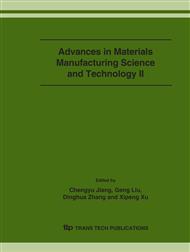p.209
p.213
p.217
p.221
p.225
p.229
p.233
p.237
p.241
Study on Technology of Micro-EDM with Lower Working Voltage
Abstract:
This paper presents new machining technology of micro-EDM with lower working voltage in RC pulse power source. How to control the discharging energy of one pulse supplied by RC power is crucial to the technology of micro-EDM. The process of discharging has been studied, then the feasibility of machining with lower working voltage has been put forward, in order to reduce the discharge energy of one pulse effectively. On the basis of a great deal of experiments, the effect of working voltage on surface quality is studied, also the effect of working voltage on machining efficiency has been found out and been analyzed theoretically. The result shows that lower working voltage can reduce the working energy observably, and then improve the machining surface quality attended by reducing of machining efficiency. However, there is a good machining effect when the working voltage is about 15~20V. Considering working efficiency, a new technology of block electro-discharge grinding (BEDG) with lower working voltage has been applied. As shown by the experimental result with the technology, the minimum diameter of micro-shaft reaches 32m. Moreover, the micro-shaft has very high surface quality of Ra 0.1252m and its coaxial diameter error is controlled within 0.152m.
Info:
Periodical:
Pages:
225-228
Citation:
Online since:
December 2006
Authors:
Price:
Сopyright:
© 2006 Trans Tech Publications Ltd. All Rights Reserved
Share:
Citation:


